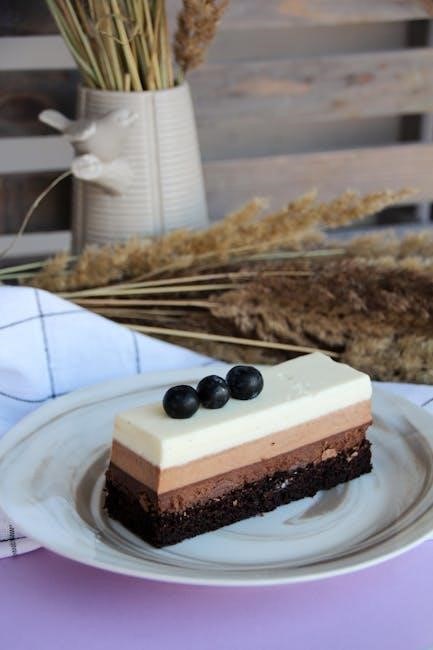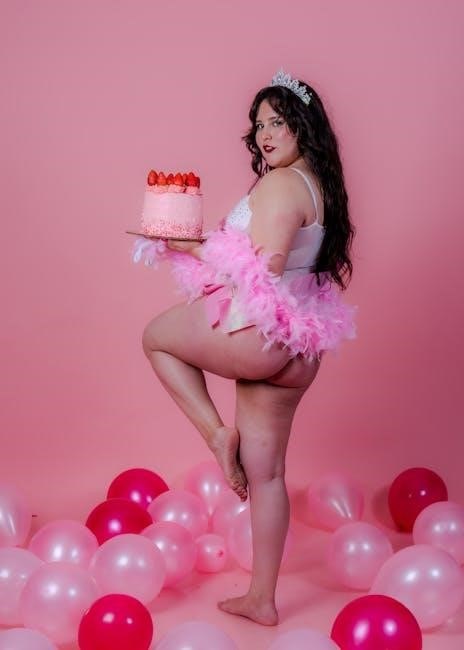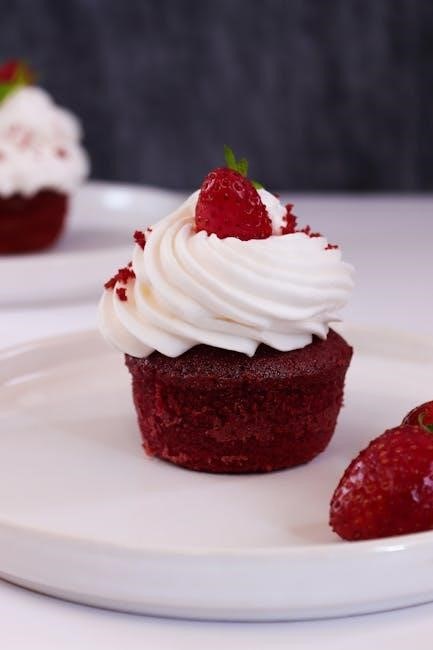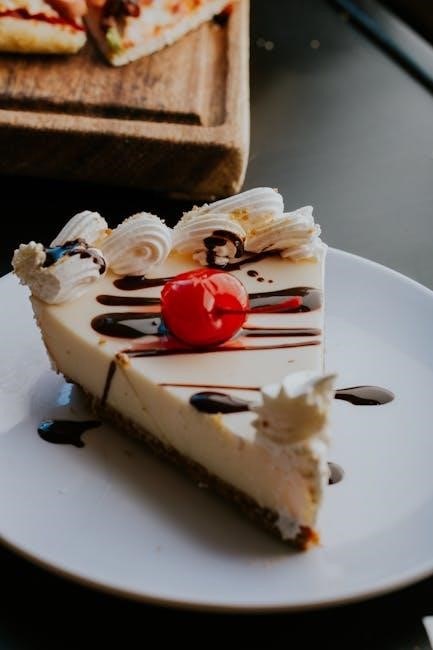Welcome to our comprehensive cake size guide! Understanding the right cake size is crucial for ensuring ample servings and a perfect presentation at any event. This guide helps you determine the ideal cake dimensions and portion sizes for parties, weddings, and more, guaranteeing everyone enjoys a delicious slice without leftovers. Learn how to choose the perfect cake size for your celebration!

Understanding Cake Serving Sizes
Cake serving sizes vary based on event type and portion preferences. Party-sized portions are typically larger, while wedding-sized servings are smaller and more standardized, ensuring consistent guest portions.
2.1. Party-Sized Servings
Party-sized servings are designed for casual gatherings and events where larger portions are preferred. These slices are typically cut to be 1.5 x 2 inches in size, offering a generous portion for guests. Unlike wedding servings, party-sized portions are less formal, making them ideal for events like birthdays or celebrations. A standard 10-inch round cake, for example, can serve about 28 people with party-sized slices. This size ensures everyone enjoys a satisfying piece without compromising on flavor or presentation.
2.2. Wedding-Sized Servings
Wedding-sized servings are smaller and more formal, typically measuring 1 inch wide and 2 inches long. This smaller portion size allows for more slices, making it ideal for large gatherings. A 10-inch round cake, for instance, can serve nearly double the number of guests compared to party-sized slices. Wedding-sized servings are standardized to ensure consistency and adequacy for all attendees, making them a practical choice for such special events where every guest deserves a perfect slice.
2.3. How Portion Size Affects Servings
The size of each cake portion directly impacts the number of servings. Smaller slices yield more servings, while larger slices reduce the total count. For example, a 10-inch round cake cut into 1×2-inch wedding-sized slices serves about 56 people, while 1.5×2-inch party-sized slices serve 28. This variance is crucial for events, as smaller portions are ideal for weddings to maximize guest servings, while larger slices are better suited for casual gatherings where heartier portions are preferred. Adjusting portion sizes ensures your cake meets the needs of your event perfectly.

Round Cake Serving Chart
A round cake serving chart provides a clear guide to determine servings based on cake size and layers. Standard diameters like 6-inch, 8-inch, and 10-inch cakes yield 5-6, 8-12, and 20-24 servings, respectively. Each additional layer increases the serving count by approximately 50%. This chart helps bakers and planners ensure the right cake size for any event, making it easy to accommodate guest numbers accurately.
3.1. Standard Round Cake Sizes and Servings
Standard round cake sizes are categorized by their diameters and corresponding servings. A 6-inch round cake typically serves 5-6 people, while an 8-inch serves 8-12, and a 10-inch serves 20-24. These estimates assume a standard cake height of 4 inches and party-sized portions of 1.5 x 2 inches. Larger diameters naturally yield more servings, making them ideal for bigger gatherings. Remember, each additional layer increases the serving count by about 50%, allowing for flexibility in accommodating more guests.
3.2. Adjusting Servings for Additional Layers
Each additional layer in a round cake increases the total number of servings by approximately half the amount of the base layer. For example, a 4-inch tall, 8-inch round cake with two layers serves 12-16 people. Adding a third layer increases servings to 18-24, and a fourth layer to 24-28. This flexibility allows you to scale the cake according to your guest list, ensuring everyone enjoys a generous portion without waste. Adjusting layers is a practical way to match your cake size to the event’s needs.
Square and Sheet Cake Serving Guide
This guide provides detailed information on square and sheet cake sizes, helping you determine the ideal number of servings for any event. Learn how to estimate portions accurately based on cake dimensions and thickness, ensuring your dessert meets everyone’s needs. Perfect for parties and large gatherings, this section offers practical tips for calculating servings and cutting cakes evenly. Discover the versatility of square and sheet cakes for your next celebration!
4.1. Square Cake Sizes and Servings
When planning your event, consider square cake sizes and their serving capacities. A 6-inch serves 6-8, an 8-inch serves 8-12, a 10-inch serves 15-20, and a 12-inch serves 20-24. Portion sizes affect servings; smaller slices yield more. Cake height and layers also influence counts. This guide helps you choose the right size for your guest count, ensuring ample servings without excess for a perfect event.
4.2. Sheet Cake Sizes and Servings
Sheet cakes are ideal for large gatherings, offering generous servings. A standard 9×13-inch sheet cake serves 12-15 people, while larger sizes like 11×15 inches can serve up to 25. Thicker cakes yield fewer servings, as slices are cut bigger, while thinner sheets allow for smaller, more numerous portions. This guide helps you select the perfect sheet cake size to accommodate your guest count effortlessly, ensuring everyone enjoys a slice.

Tiered Cake Combinations
Tiered cakes offer stunning visuals and practicality, combining multiple sizes to serve large groups. Each tier adds versatility, allowing for varied flavors and designs while ensuring ample servings for events;
5.1. Common Tier Combinations for Weddings
Tiered cakes are a popular choice for weddings, offering both elegance and functionality. Common combinations include a three-tier setup with sizes like 6-8-10 inches or 8-10-12 inches, serving 50-150 guests. Four-tier cakes, such as 6-8-10-12 inches, can serve up to 200 guests. Each tier is typically 4 inches tall, allowing for even serving. The bottom tier serves the majority, while smaller tiers can be reserved for the wedding couple or special guests. This setup ensures variety and meets diverse guest preferences.
5.2. Calculating Total Servings for Tiered Cakes
To calculate total servings for tiered cakes, consider each tier’s size and layers. A standard tier with two 4-inch layers serves 8-12 people per 10-inch round cake. For larger tiers, add half the servings for each additional layer. For example, a 10-inch tier with three layers serves 12-16. Sum the servings from all tiers to get the total. Ensure each tier’s height and diameter align with your guest count for accurate planning and a stress-free event.

Cake Serving Portion Chart
A cake serving portion chart provides standard slice dimensions for events. Party-sized slices are 1.5 x 2 inches, while wedding-sized slices are 1 x 2 inches, ensuring accurate servings.
6.1. Visual Guide for Estimating Serving Sizes
A visual guide simplifies estimating serving sizes by providing clear measurements. Party-sized slices are typically 1.5 x 2 inches, while wedding-sized slices are 1 x 2 inches. Use this chart to gauge servings based on cake size and layer height. For example, an 8-inch round cake with two layers yields 8-12 party servings or 12-16 wedding servings. Additional layers increase servings proportionally. This visual approach ensures consistent portioning, helping you serve the right amount without waste or shortage.
6.2. Serving Size Variations for Different Events
Serving sizes vary based on the event type. For parties, larger slices (1.5 x 2 inches) are common, yielding fewer servings. Wedding cakes often use smaller slices (1 x 2 inches) to serve more guests. Formal events may require thinner slices, while casual gatherings allow for generous portions. Adjusting slice size ensures your cake meets the event’s needs, whether it’s a grand wedding or an intimate celebration. This flexibility helps in planning the perfect cake for any occasion.

Baking Tips for Perfect Cake Sizes
Ensure perfectly sized cakes by accurately measuring pans, leveling batter evenly, and baking at the right temperature. Proper cooling prevents shrinkage for precise results.
7.1. Measuring Cake Pans for Accuracy
Accurate cake pan measurement is essential for achieving the right size and shape. Always measure the pan’s diameter and depth to ensure batter fits perfectly. Use a measuring tape for precise dimensions. Properly grease and line pans to prevent sticking. Fill pans evenly, avoiding overfilling, as this can cause overflow during baking. Cooling cakes in pans before transferring ensures they retain their shape. These steps guarantee professional results and perfect cake sizing every time.
7.2. Ensuring Even Layer Heights
For professional-looking cakes, achieving even layer heights is crucial. Start by using pans of the same size and depth. Bake layers on the same oven rack to ensure consistent heating. Use a level to check your oven rack alignment. After baking, cool layers completely before leveling with a serrated knife or cake leveler. This ensures a stable base for stacking and frosting, creating a polished finish. Proper layer height management guarantees a visually appealing and evenly proportioned cake for any occasion.
Frequently Asked Questions
Got questions about cake sizing? From determining the right size for your event to adjusting servings for leftovers, this section answers your most common cake-related queries.
8.1. How to Determine the Right Cake Size for Your Event
To choose the perfect cake size, start by assessing your guest count and serving preferences. Consider whether you’re hosting a party or a wedding, as serving sizes differ. Party-sized slices are larger, while wedding portions are smaller. Measure your cake pans or tiers to match the number of guests. Use a cake serving chart to estimate servings based on dimensions and layers. Adjust for extras like leftovers or varying portion sizes to ensure everyone enjoys a slice!
8.2. Can Serving Sizes Be Adjusted for Leftovers?
Yes, serving sizes can be adjusted to accommodate leftovers. For a more generous portion, cut larger slices, reducing the total number of servings. Alternatively, smaller slices increase the yield, ensuring extra cake for later. Keep in mind that standard serving sizes are guides, and adjustments depend on your event’s needs. If you prefer having leftovers, consider cutting uneven slices or setting aside uneaten portions. This flexibility allows you to balance guest satisfaction with practicality.
Tools and Resources for Cake Sizing
Utilize cake serving calculators and printable size charts to plan perfectly sized cakes. These tools help estimate servings, ensuring your cake meets event demands without waste or shortage.
9.1. Cake Serving Calculators
Cake serving calculators are invaluable tools for determining the perfect number of servings based on your cake’s size and shape. These calculators allow you to input dimensions and instantly estimate how many guests you can serve. They often account for both party-sized and wedding-sized portions, ensuring accuracy. Whether you’re planning a small gathering or a grand wedding, these calculators help prevent under- or overestimating cake needs. Use them to streamline your planning and ensure every guest enjoys a slice. They’re simple, efficient, and essential for any baker or event planner.
9.2. Printable Cake Size Charts
Printable cake size charts offer a convenient way to plan your event with precision. These charts provide clear visuals and measurements for various cake sizes, serving as a quick reference for determining servings. They often include standard round, square, and sheet cake dimensions, along with portion guides. Print them out and use them to visualize your cake setup or share with decorators. These charts are perfect for event planning, ensuring you order or bake the right size cake for your guest count. They save time and reduce stress, making them an essential tool for any celebration.
